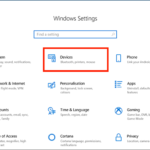Sleep mode and hibernate mode are the perfect choices when you want to shut down your computer but still keep your work state when you turn it back on. However, many people are not clear about how to enable or disable sleep mode on Windows 10 and its benefits. Let’s find out.
Is Hibernate mode the same as Sleep mode?
The answer is no. Although both modes aim to save energy, they have different approaches and applications based on how they store and restore the system state. Here are the basic differences between these two modes:
Sleep mode
- Active state: In sleep mode, the computer reduces its activity but does not completely turn off the power.
- Energy-saving: The computer still consumes a small amount of energy to maintain the sleep state and quickly becomes active when triggered.
- Resume time: The time for the computer to “wake up” from sleep mode is usually very fast, taking only a few seconds.
- RAM data: The data in the RAM is still preserved, helping the computer to quickly recover.
Hibernate mode
- Active state: In hibernate mode, the computer saves the current system state to a hibernation file and completely shuts off the power.
- Energy-saving: The computer does not consume any energy when in hibernate mode because it has been completely powered off.
- Resume time: The time for the computer to restart from hibernate mode is usually longer than sleep mode because it needs to read data from the hibernation file.
- RAM data: The data in the RAM is stored on the hard drive, so it is not preserved in its original state when the computer restarts.
How to enable or disable Hibernate mode on Windows 10
To enable or disable Hibernate mode on Windows 10, you can follow these steps.
How to enable or disable Hibernate mode on Windows 10
Step 1: There are 2 ways to open the Hibernate mode management interface.
- Method 1: Press the Windows + X key combination → Select Power Options.
- Method 2: Press the Windows + I key combination → System → Power & Sleep.
Next, in the settings panel → Click on Additional Power Settings.
/fptshop.com.vn/uploads/images/tin-tuc/167972/Originals/cach-bat-tat-che-do-ngu-dong-win-10_2(1).jpg)
Step 2: The Power Options interface will open → Select Choose what the power buttons do.
/fptshop.com.vn/uploads/images/tin-tuc/167972/Originals/cach-bat-tat-che-do-ngu-dong-win-10_3.jpg)
Step 3: Then, the System Settings interface will appear → In this interface, select Change settings that are currently unavailable (Location with a blue + yellow shield icon).
/fptshop.com.vn/uploads/images/tin-tuc/167972/Originals/cach-bat-tat-che-do-ngu-dong-win-10_4.jpg)
Step 4: Next, observe the Shutdown settings section → In the Hibernate section, uncheck to disable hibernate mode, or check to enable hibernate mode. → Then, save the changes by selecting Save changes. That’s it, you have finished the steps to enable or disable Hibernate mode on Windows 10!
/fptshop.com.vn/uploads/images/tin-tuc/167972/Originals/cach-bat-tat-che-do-ngu-dong-win-10_5.jpg)
How to enable or disable Sleep mode on Windows 10
Step 1: Press the Windows + I key combination → System → Select Power & Sleep in the left sidebar of the interface.
/fptshop.com.vn/uploads/images/tin-tuc/167972/Originals/cach-bat-tat-che-do-ngu-dong-win-10_6.jpg)
Step 2: The Sleep section will have 2 settings for you to choose from:
- On battery power, PC goes to Sleep after: This is the time set for the computer to automatically enter sleep mode when running on battery power. You can set the time after which the computer will enter sleep mode if there is no activity.
- When plugged in, PC goes to Sleep after: This is the time set for the computer to automatically enter sleep mode when plugged in. You can set the specific time when the computer will enter sleep mode when it is plugged in.
Normally, a computer with the Windows 10 operating system will be automatically activated with Sleep mode. In this mode, you can freely adjust the time that suits you.
Step 3: In the second step, you can enable Sleep mode. However, if you want to disable this mode, you just need to switch the 2 settings to Never.
/fptshop.com.vn/uploads/images/tin-tuc/167972/Originals/cach-bat-tat-che-do-ngu-dong-win-10_9.jpg)
The benefits of enabling Hibernate mode for your computer
Using Hibernate mode for your computer brings many benefits, especially in terms of energy saving and enhancing user experience. Here are some key benefits.
/fptshop.com.vn/uploads/images/tin-tuc/167972/Originals/cach-bat-tat-che-do-ngu-dong-win-10_8.jpg)
Energy-saving
When the computer is in Hibernate mode, it will consume very little or no power if advanced wireless devices like Wi-Fi are used.
Data and work state protection
Hibernate mode retains work state and all applications you are using. When the computer wakes up, you can continue your work without having to start over.
Convenience and speed
The computer can wake up very quickly when needed, saving time and not interrupting your work.
Battery life protection (for laptops)
For laptops, Hibernate mode helps protect the battery life by reducing fatigue from continuous use and charging.
Noise and temperature reduction
In Hibernate mode, fans and thermal components operate less, reducing noise and lowering the computer’s temperature.
Increased device lifespan
Reducing fatigue and the thermal impact on computer components can help extend the lifespan of the device.
In conclusion
Above are simple steps to enable or disable Hibernate mode on Windows 10 and the differences between Sleep and Hibernate modes. Both settings allow you to control the time before the computer automatically enters sleep mode, depending on whether it is using battery power or plugged in. Hopefully, this article will help you use these modes more effectively.
Read more




































